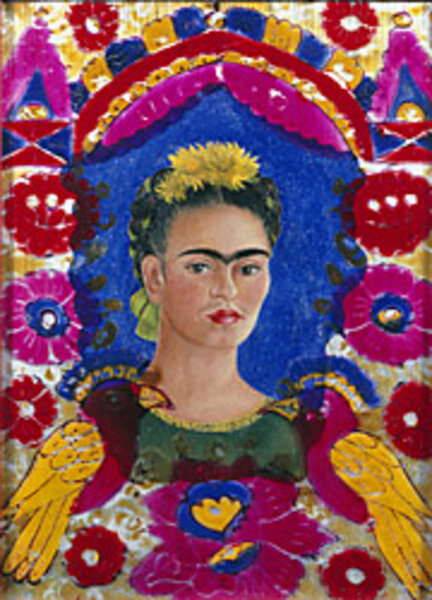Frida Kahlo: a full life, fully expressed
Loading...
Before there was the Frida Kahlo phenomenon – the major motion picture, full-length biography, and museum-shop commercialization – there was simply Frida Kahlo, autodidactic Surrealist artist, strong woman defiant of injuries and physical challenges, and symbol of an emerging Mexico that was emphatically in touch with its indigenous roots.
To be sure, Kahlo (1907-54) knew how to attract phenomenal attention during her lifetime and intuitively anticipated the age of the celebrity artist by consciously turning herself into a work of art and her public appearances into near performances.
However, since her death, Kahlo has been appropriated as the feminist heroine par excellence. This complex figure is often pigeonholed as little more than the embodiment of female assertiveness, an image derived from her self-portraits, where she gained instant recognition as the possessor of perhaps the most famous eyebrows in the history of art.
But the totality of Frida Kahlo's life and work is more than that. Behind Kahlo's carefully cultivated, sometimes outrageous, public facade was a person for whom art was a lifeline, a way of actuating emotional and physical self-preservation during a sometimes bleak existence with frequent health challenges resulting from an accident in her youth.
Although Kahlo broke boundaries for women, perhaps her primary concerns were her native Mexico and her own survival. The affirmation of the roots of indigenous Mexican identity was one of the main purposes of her art. The overcoming of injury is a significant component in the inspiration her life provides for others.
"Frida Kahlo," a major exhibition at the Philadelphia Museum of Art, explores Kahlo's artistic journey of self-discovery through 42 paintings, approximately half of which are self-portraits. Many of the canvases are not pretty pictures in the conventional sense, but raw, questing statements of self-examination and unburdening of fears – a visual autobiography of vicissitudes and triumphs.
Kahlo's artistic career might never have happened without the catalyst of injuries sustained in a Mexico City bus accident in 1925, and her refusal to be thwarted by the ensuing physical difficulties.
During her long recuperation, Kahlo began to paint on an easel that was especially designed and constructed by her parents to allow her to paint while lying down. Using a mirror to see her own image, she painted her first self-portrait in 1926, a picture not of an invalid, but of a strong, well woman with what became those immediately identifiable eyebrows.
"The only thing I know is that I paint because I need to," Kahlo said, and self-portraiture became her signature theme, accounting for approximately a third of her oeuvre. "I paint myself because I am alone. I am the subject I know best."
Kahlo was initially self-taught, and her pictures represent her own version of Surrealism, which she practiced before becoming familiar with the European Surrealist movement. "I never painted dreams, I painted my own reality," she observed.
In 1929, Kahlo married Diego Rivera, the famous Mexican painter and muralist, launching her into the center of political and cultural events in Mexico. The often-stormy relationship with Rivera, which culminated in divorce and then remarriage, became the theme of many paintings, several included in this exhibit.
"The Two Fridas" (1939) is a fraught depiction of Kahlo's emotional state following separation from her husband. In "Diego and Frida, 1929-44," (1944) Kahlo imaginatively portrays herself and Rivera as two halves of one person. Rivera succinctly described his wife's approach to art: "[S]he paints at the same time the exterior and interior of herself."
In her life and art, Kahlo embodied "Mexicanidad," a return to appreciating indigenous Indian roots of culture in a Mexico that had long been dominated by Europe. Kahlo adopted the practice of wearing traditional Mexican clothing, specifically a dress representative of the region of Mexico called Tehuana, a matriarchal society where women assume leading social roles. Since childhood, Kahlo had expressed her Mexican identity in her family home, "the Blue House," in Coyoacán, outside Mexico City – now a museum to her memory. More than 100 photos of Kahlo's life, including some of the Blue House, are featured in the exhibit.
Placing herself emphatically in the Mexican context, "The Frame" (circa 1937-38), a self-portrait pictured here, shows Kahlo surrounded by exuberant flowers in the pinks, yellows, and reds often associated with her native land.
Kahlo is also known for her still lifes, and a number are included in this show, particularly paintings of Mexican fruits and vegetables. Indeed, Kahlo's last painting was a still life of watermelon, a fruit popular in Mexico. On a piece of watermelon on the canvas, she inscribed her own message: "Viva la Vida" (translated into English as "Live life").
Although challenged by many obstacles, Kahlo lived life to the fullest, leaving an unusually self-revealing artistic record of what it felt like to be this unique, bold, and joyously Mexican painter.
• The exhibit will be at the Philadelphia Museum of Art until May 18. It will be at the San Francisco Museum of Modern Art from June 14 – Sept. 28.





